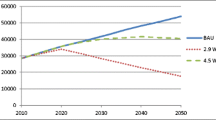Abstract
This paper analyses the optimal timing and macro-economic costs of carbon emission reductions that mitigate the global average atmospheric temperature increase. We use a macro-economic model in which there are two competing energy sources, fossil-fuelled and non-fossil-fuelled. Technological change is represented endogenously through learning curves, and niche markets exist implying positive demand for the relatively expensive non-fossil-fuelled energy source. Under these conditions, with a temperature increase constraint of 2 ° C, early abatement is found to be optimal, and, comparedto the results of many existing top-down models, the costs of this strategy prove to be low. We perform an extensive sensitivity analysis of our results regarding the uncertainties that dominate various economic and technological modeling parameters. Uncertainties in the learning rate and the elasticity of substitution between the two different energy sources most significantly affect the robustness of our findings.
Similar content being viewed by others
References
Abler, D. G., Rodriguez, A. G., and Shortle, J. S.: 1999, ‘Parameter Uncertainty, CGE Modelling of the Environmental Impacts of Economic Policies’, Environ. Resour. Econ. 14, 75–94.
Anderson, D. and Bird, C. D.: 1992, ‘Carbon Accumulation and Technical Progress–A Simulation Study of Costs’, Oxford Bulletin of Economics and Statistics 54, 1–27.
Arrow, K. J.: 1961, ‘The Economic Implications of Learning by Doing’, Review of Economic Studies 29, 155–173.
Arthur, W. B., Ermoliev, Y. M., and Kanjovski, Y. M.: 1987, ‘Path-Dependent Processes and the Emergence of Macro-Structure’, European J. Operational Research 30, 294–303.
Berry, R. S., Heal, G., and Salomon P.: 1978, ‘On a Relation between Economic and Thermodynamic Optima’, Resources and Energy 1, 125–137.
Carraro, C., Gerlagh, R., and van der Zwaan, B.: 2003, ‘Endogenous Technical Change in Environmental Macroeconomics’, Editorial, Resource and Energy Economics 25, 1–10.
Chakravorty, U., Roumasset, J., and Tse, K.: 1997, ‘Endogenous Substitution among Energy Resources and Global Warming’, J. Political Economy 105, 1201–1234.
Chen, B.-L. and Shimomura, K.: 1998, ‘Self-Fulfilling Expectations and Economic Growth: A Model of Technology Adoption and Industrialization’, International Economic Review 39, 151–170.
Dosi, G., Ermoliev, Y. M., and Kaniovski, Y.: 1994, ‘Generalized Urn Schemes and Technological Dynamics’, J. Mathematical Economics 23, 1–19.
Gerlagh, R., van der Zwaan, B. C. C., Hofkes, M.W., and Klaassen, G.: 2004, ‘Impacts of CO2-Taxes when there are NicheMarkets and Learning-by-Doing’, Environmental and Resource Economics, in press.
Gerlagh, R. and van der Zwaan, B. C. C.: 2003, ‘Gross World Product and Consumption in a Global Warming Model with Endogenous Technological Change’, Resource and Energy Economics 25, 35–57.
Goulder, L. H. and Schneider, S. H.: 1999, ‘Induced Technological Change and the Attractiveness of CO2 Abatement Policies’, Resource and Energy Economics 21, 211–253.
Grübler, A. and Messner, S.: 1998, ‘Technological Change and the Timing of Mitigation Measures’, Energy Economics 20, 495–512.
Harrison, G. W., Jones, R., Kimbell, L. J., and Wigle, R.: 1993, ‘How Robust is Applied General Equilibrium Analysis?’, J. Policy Modeling 15, 99–115.
Hasselmann, K., Hasselmann, S., Giering, R., Ocana V., and v. Storch, H.: 1997, ‘Sensitivity Study of Optimal CO2 Emission Paths Using a Simplified Structural Integrated Assessment Model (SIAM)’, Clim. Change 37, 345–386.
IEA/OECD: 1999, Key World Energy Statistics, International Energy Agency, OECD, Paris.
IEA/OECD: 2000, Experience Curves for Energy Technology Policy, International Energy Agency, OECD, Paris.
Knapp, K. E.: 1999, ‘Exploring Energy Technology Substitution for Reducing Atmospheric Carbon Emissions’, Energy J. 20, 121–143.
Kremer, M. and Marcom C.: 2000, ‘Elephants’, American Economic Review 90, 212–234.
Krugman, P.: 1991, ‘History versus Expectations’, Quarterly J. Economics 106, 651–667.
Mankiw, N. G., Romer, D., and Weil, D. N.: 1992, ‘A Contribution to the Empirics of Economic Growth’, Quarterly J. Economics 107, 407–437.
Manne, A. S., Mendelsohn, R., and Richels R.: 1995, ‘MERGE, A Model for Evaluating Regional and Global Effects of GHG Reduction Policies’, Energy Policy 23, 17–34.
McDonald, A. and Schrattenholzer, L.: 2001, ‘Learning Rates for Energy Technologies’, Energy Policy 29, 255–261.
Messner, S.: 1995, Endogenized Technological Learning, An Energy Systems Model, WP-95–114, IIASA, Laxenburg, Austria.
Nelson, R. R.: 1995, ‘Recent Evolutionary Theorizing about Economic Change’, J. Economic Literature 33, 48–90.
Nordhaus, W. D.: 1994, Managing the Global Commons, MIT Press, Cambridge, Massachusetts.
Nordhaus, W. D. and Yang, Z.: 1996, ‘A Regional Dynamic General Equilibrium Model of Alternative Climate-Change Strategies’, American Economic Review 86, 741–765.
Peck, S. C. and Teisberg, T. J.: 1992, ‘CETA, AModel for Carbon Emissions Trajectory Assessment’, Energy J. 13, 55–77.
Portney, P. R. and Weyant, J. P. (eds.): 1999, Discounting and Intergenerational Equity, Resources for the Future, Washington, D.C.
Romer, P. M.: 1989, ‘Capital Accumulation and Long-Term Growth’, in Barro, R. J. (ed.), Modern Business Cycles Theory, Blackwell, Oxford, U.K.
Schneider, S. H. and Azar, C.: 2001, ‘Are Uncertainties in Climate and Energy Systems A Justi-fication for Stronger Near-Term Mitigation Policies?’, Pew Center on Global Climate Change, www.pewclimate.org/events, Workshop Paper, October 2001.
Tol, R. S. J.: 1999, ‘Spatial and Temporal Efficiency, Climate Policy, Applications of FUND’, Environ. Resour. Econ. 14, 33–49.
Wigley, T. M. L., Richels, R., and Edmonds, J. A.: 1996, ‘Economic and Environmental Choices, the Stabilization of Atmospheric CO2 Concentrations’, Nature 379, 240–379.
Wright, T. P.: 1936, ‘Factors Affecting the Cost of Airplanes’, J. Aeronautical Sciences 3, 122.
van der Zwaan, B. C. C., Gerlagh, R., Klaassen, G., and Schrattenholzer L.: 2002, ‘Endogenous Technological Change in Climate Change Modelling’, Energy Economics 24, 1.
Author information
Authors and Affiliations
Rights and permissions
About this article
Cite this article
Gerlagh, R., van der Zwaan, B. A Sensitivity Analysis of Timing and Costs of Greenhouse Gas Emission Reductions. Climatic Change 65, 39–71 (2004). https://doi.org/10.1023/B:CLIM.0000037497.49722.c5
Issue Date:
DOI: https://doi.org/10.1023/B:CLIM.0000037497.49722.c5




